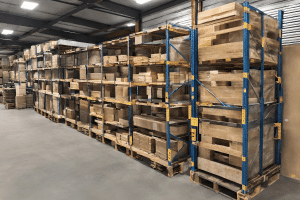Efficient pallet storage is crucial for businesses in Singapore, especially in industries such as logistics, warehousing, and manufacturing. With limited space and high storage demands, it is essential to optimize pallet storage to maximize capacity and streamline operations. This blog explores efficient solutions and strategies for pallet storage in Singapore, including proper layout planning, advanced storage systems, and smart inventory management. Whether you are a small business or a large enterprise, implementing these solutions will help you meet your business needs and improve overall efficiency.

The benefits of optimizing pallet storage
Optimizing pallet storage can bring numerous benefits to your business in Singapore. By implementing efficient solutions, you can enhance your warehouse operations, improve productivity, and maximize your storage capacity. Here are some key advantages of optimizing pallet storage:
1. Increased storage capacity: By utilizing advanced storage systems and proper layout planning, you can make the most of your warehouse space. This means you can store more products without the need for additional square footage.
2. Streamlined operations: With optimized pallet storage, you can reduce inefficiencies such as double handling and unnecessary movement of pallets. This streamlines your operations, allowing for faster order fulfillment and improved customer satisfaction.
3. Enhanced inventory management: Efficient pallet storage solutions enable better organization and tracking of inventory. With proper labeling and categorization, you can easily locate and manage your stock, reducing the risk of misplaced or lost items.
4. Cost savings: By making the most of your available space and improving overall efficiency, you can minimize storage costs. Optimized pallet storage reduces the need for additional facilities or outsourcing storage, leading to cost savings for your business.
In the next section, we will delve deeper into the various efficient solutions for pallet storage in Singapore.
Evaluating your business needs
Before implementing any efficient solutions for pallet storage in Singapore, it is crucial to evaluate your business needs. This assessment will help determine the specific requirements and goals you have for your warehouse operations. Here are some key factors to consider:
- Inventory volume: Analyze the volume and variety of products you handle. This will help determine the type and size of storage systems required to accommodate your inventory.
- Inventory turnover: Consider how quickly your inventory needs to move in and out of your warehouse. Higher turnover rates may require more flexible storage solutions to ensure efficient access and retrieval.
- Storage and handling equipment: Evaluate the type and condition of your current storage and handling equipment. This will help identify any needs for upgrades or replacements to optimize efficiency and safety.
- Workflow and processes: Assess your existing workflows and processes to identify any bottlenecks or areas for improvement. Look for opportunities to streamline these processes and eliminate unnecessary steps.
- Future growth plans: Consider your future growth projections and how they may impact your storage needs. This will help determine scalable solutions that can accommodate your expanding inventory.
By carefully evaluating these factors, you can make informed decisions when selecting the most appropriate and efficient pallet storage solutions for your business in Singapore.

Assessing the available storage solutions in Singapore
Once you have evaluated your business needs, it is essential to assess the available storage solutions in Singapore to find the most suitable option for your business. Singapore offers a wide range of innovative and efficient pallet storage solutions designed to maximize space utilization and optimize warehouse operations. Here are some popular options to consider:
- Selective pallet racking: This is the most common and versatile storage system, allowing easy access to each pallet. It is suitable for businesses with a diverse range of products and varying pallet sizes.
- Double-deep racking: Perfect for high-density storage, double-deep racking allows two pallets to be stored back-to-back, increasing storage capacity while maintaining selectivity.
- Drive-in racking: Ideal for homogeneous products with a large volume, drive-in racking provides high-density storage by allowing forklifts to drive directly into the racking system.
- Push-back racking: Offering high density and selectivity, push-back racking allows for multiple pallets to be stored on inclined rails, with the ability to access any pallet without shifting others.
- Automated storage and retrieval systems (AS/RS): AS/RS technology uses robotic systems to retrieve and store pallets, maximizing efficiency and saving space in high-volume warehouses.
By assessing these available storage solutions in Singapore, you can determine which one aligns best with your business needs and goals.
Choosing the right pallet storage system
Now that you have assessed the available storage solutions in Singapore, it is time to choose the right pallet storage system for your business. Each option has its own benefits and considerations, which can greatly impact your warehouse operations and productivity. By selecting the most suitable solution, you can optimize your pallet storage and enhance the efficiency of your business.
Consider the following factors when making your decision:
- Storage capacity: Determine the amount of storage space required to accommodate your inventory. Ensure that the selected system can meet your storage needs without compromising accessibility.
- Accessibility: Consider how often you need to access your inventory. If frequent access is required, selective pallet racking or push-back racking may be the ideal choice.
- Product variety: If you have products of different sizes and shapes, selective pallet racking or double-deep racking would provide the necessary flexibility and versatility.
- Inventory turnover: Assess the rate at which your inventory moves. If you have a high inventory turnover, an automated storage and retrieval system (AS/RS) could streamline your operations and improve efficiency.
- Budget: Evaluate the cost-effectiveness of each storage solution. Consider not only the initial investment but also any ongoing maintenance and operating expenses.
By carefully considering these factors, you can make an informed decision and select the pallet storage system that best meets your business needs.
Implementing efficient storage practices
Now that you have chosen the right pallet storage system for your business, it’s time to implement efficient storage practices to maximize its effectiveness. Optimizing your storage space goes beyond just selecting the right system – it also involves utilizing the space efficiently and organizing your inventory strategically.
Here are some tips to help you implement efficient storage practices:
- Utilize vertical space: Make the most of your warehouse height by stacking pallets vertically. Use forklifts or reach trucks to access higher levels safely and efficiently.
- Categorize and label inventory: Implement a clear labeling and categorization system to make it easy for warehouse staff to locate and retrieve items. This will minimize search times and prevent errors.
- Implement a first-in, first-out (FIFO) system: To prevent stock from becoming obsolete, use a FIFO system to ensure that older products are used or sold first. Label each item with its receipt date for easy identification.
- Regularly conduct inventory audits: Perform regular inventory audits to identify slow-moving or excess stock. This will help you make informed decisions about restocking, discounting, or reorganizing your inventory.
- Train warehouse staff: Properly train your warehouse staff on the efficient use of the pallet storage system. Ensure they understand how to safely handle pallets, operate equipment, and locate items quickly.

Training your team on proper pallet storage techniques
Proper training is essential for ensuring that your team is equipped with the knowledge and skills to effectively utilize the pallet storage system. By training your warehouse staff on proper pallet storage techniques, you can enhance efficiency, minimize errors, and reduce the risk of accidents or damage to inventory.
Here are some key areas to focus on when training your team:
- Safe handling of pallets: Teach your warehouse staff how to safely handle and stack pallets to prevent injuries and damage to inventory. Emphasize the importance of proper lifting techniques and the use of equipment such as forklifts or pallet jacks.
- Operating equipment: Provide comprehensive training on the safe operation of forklifts, reach trucks, or other equipment used in your pallet storage system. Ensure that your staff understands how to maneuver the equipment and follow all safety protocols.
- Efficient inventory retrieval: Train your team on how to quickly and accurately locate items within the pallet storage system. Teach them effective techniques for navigating the warehouse and utilizing the labeling and categorization system.
- Maintenance and upkeep: Educate your team on the importance of regular maintenance and upkeep of the pallet storage system. Teach them how to identify and report any issues or malfunctions to ensure the system remains in optimal condition.
Regularly assess the training needs of your team and provide ongoing support to ensure that they stay updated on the best practices for pallet storage. By investing in training, you can empower your team to optimize storage efficiency and contribute to the overall success of your business.
Monitoring and maintaining your pallet storage system.
Once your team is well-trained on proper pallet storage techniques, it is important to establish a system for monitoring and maintaining the pallet storage system. Regular monitoring and maintenance will help ensure that your system continues to operate efficiently and effectively.
Here are some steps to consider when monitoring and maintaining your pallet storage system:
- Regular inspections: Schedule routine inspections of your pallet racking and shelving to identify any signs of damage or wear. Look for cracked or bent frames, loose bolts, or any other abnormalities that could compromise the integrity of the system.
- Repair or replace damaged components: If during inspections you identify any damaged components, it is important to promptly repair or replace them. This will help prevent further damage and ensure the safety of your staff and inventory.
- Keep aisles clear: Regularly check that the aisles in your warehouse are clear of debris, empty pallets, or any other obstacles that could impede the movement of goods. Keeping the aisles clear will help maximize efficiency and prevent accidents.
- Ensure proper load distribution: Monitor the weight distribution on your pallet racking to prevent overloading and uneven weight distribution. This will help maintain the structural integrity of the system and prevent accidents.
By implementing regular monitoring and maintenance practices, you can proactively address any issues or potential problems, ensuring that your pallet storage system continues to operate at its best. This will not only enhance efficiency but also extend the lifespan of your pallet racking and contribute to cost savings in the long run.

